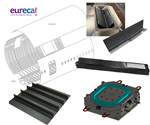Clean Sky 2 program publishes 2019 report
Clean Sky’s 2019 report highlights innovative technologies like a thermoplastic fuselage barrel, digitization of aircraft maintenance and more.

Source | Clean Sky
Clean Sky issued a report on May 11 highlighting the program’s 2019 accomplishments. The program described 2019 as its most significant year for greener aviation in fields such as aerodynamics and aircraft configuration. Funded by the European Commission, the Clean Sky 2 public-private partnership is halfway through its program and on track to deliver its objectives to reduce emissions and noise in aircraft, aligning with the European Commission’s Green Deal and its vision for climate neutrality in aviation.
Clean Sky has also successfully established a collaborative network and supply chain for the Clean Sky 2 program, engaging more than 900 actors across the public and private sector. Of these, 340 are SMEs, 110 are research centers, 150 are universities and 300 represent the aviation industry.
The 2019 report explores a variety of Clean Sky’s main achievements. One includes an 8-meter long fuselage barrel made of thermoplastic composites, designed to increase assembly flexibility and reduce fuselage weight by 1 tonne. Other highlights encompass developing and ground-testing hybrid-electric propulsion systems for regional and short-medium range aviation and new wing technologies for operation flexibility. Read the full report here.
Related Content
-
Plant tour: Daher Shap’in TechCenter and composites production plant, Saint-Aignan-de-Grandlieu, France
Co-located R&D and production advance OOA thermosets, thermoplastics, welding, recycling and digital technologies for faster processing and certification of lighter, more sustainable composites.
-
Novel composite technology replaces welded joints in tubular structures
The Tree Composites TC-joint replaces traditional welding in jacket foundations for offshore wind turbine generator applications, advancing the world’s quest for fast, sustainable energy deployment.
-
Composites end markets: Electronics (2024)
Increasingly, prototype and production-ready smart devices featuring thermoplastic composite cases and other components provide lightweight, optimized sustainable alternatives to metal.












